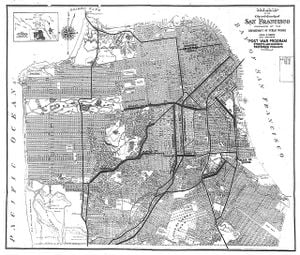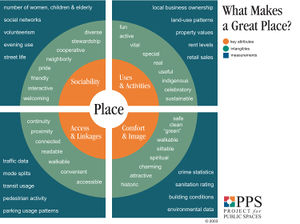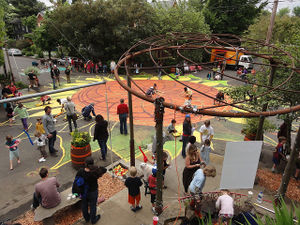MaryM.Vogel (talk | contribs) (Created page with "== The Grid System == City Repair Project began in 2001, in efforts to reclaim the civil aspect of civilization when it came to the modern urban grid standard. Although not the ...") |
MaryM.Vogel (talk | contribs) No edit summary |
||
| Line 2: | Line 2: | ||
City Repair Project began in 2001, in efforts to reclaim the civil aspect of civilization when it came to the modern urban grid standard. Although not the first to utilize the [http://en.wikipedia.org/wiki/Grid_plan grid system], the Romans largely introduced the urban grid as an effective city planning system (http://theworldisurban.com/2011/06/history-of-the-grid/). | City Repair Project began in 2001, in efforts to reclaim the civil aspect of civilization when it came to the modern urban grid standard. Although not the first to utilize the [http://en.wikipedia.org/wiki/Grid_plan grid system], the Romans largely introduced the urban grid as an effective city planning system (http://theworldisurban.com/2011/06/history-of-the-grid/). | ||
[[File:4463558583 a3d77d9ea9 z.jpg|thumb|left|]] | [[File:4463558583 a3d77d9ea9 z.jpg|thumb|left|]] | ||
In the grid system, travelers could meet with other travelers at regular intervals, where the streets intersected. But as people began to drive cars more often, the intimate interaction started to dwindle. Intersections | In the grid system, travelers could meet with other travelers at regular intervals, where the streets intersected. But as people began to drive cars more often, the intimate interaction started to dwindle. Intersections have become places where traffic builds up, people don’t signal, and people are accidentally killed by one another. | ||
CRP advocates believe that the grid system has lead to people feeling isolated from their communities, and has thereby made it difficult for community space to flourish. Whereas cities and towns without a grid system have naturally occurring space for gatherings, with the grid system, meeting places need to be deliberately planned (http://cityrepair.org/about/why-city-repair/). | CRP advocates believe that the grid system has lead to people feeling isolated from their communities, and has thereby made it difficult for community space to flourish. Whereas cities and towns without a grid system have naturally occurring space for gatherings, with the grid system, meeting places need to be deliberately planned (http://cityrepair.org/about/why-city-repair/). | ||
== Placemaking == | == Placemaking == | ||
Architects and city planners have been conceptualizing human reclamation of streets [[File:PlaceDiagram.jpg|thumb|right]] since the 1960s. [http://en.wikipedia.org/wiki/Jane_Jacobs Jane Jacobs] and [http://en.wikipedia.org/wiki/William_H._Whyte William H. Whyte] were among the first pioneers of city planing that was centered on people’s needs and aspirations, not cars and supermarkets. This idea is called [http://www.pps.org/reference/what_is_placemaking/ Placemaking], and its visionaries believe that “when you focus on place, you do everything differenly.” (http://www.pps.org/reference/what_is_placemaking/). | |||
Architects and city planners have been conceptualizing human reclamation of streets since the 1960s. [http://en.wikipedia.org/wiki/Jane_Jacobs Jane Jacobs] and [http://en.wikipedia.org/wiki/William_H._Whyte William H. Whyte] were among the first pioneers of city planing that was centered on people’s needs and aspirations, not cars and supermarkets. This idea is called Placemaking, and its visionaries believe that “when you focus on place, you do everything differenly.” (http://www.pps.org/reference/what_is_placemaking/). By opening neighborhood planning to local residents, the focus shifts from managing people as they shuffle between A and B, to empowering residents to shape their own community experience. | By opening neighborhood planning to local residents, the focus shifts from managing people as they shuffle between A and B, to empowering residents to shape their own community experience. | ||
== Sunnyside Piazza == | == Sunnyside Piazza == | ||
[[File:SunnysidePiazza.jpg|thumb|left]] | |||
The Sunnyside Piazza is perhaps one of CRP’s most famous projects. This inner-city street in Portland, OR. was transformed into a community space in 2001, in efforts to reduce neighborhood crime and increase individual sense of place (http://www.pps.org/great_public_spaces/one?public_place_id=504). The project seems to have had a positive effect; a study by Jan C. Semenza showed that people in the Sunnyside neighborhood were 30% happier with their neighborhood than people in a nearby neighborhood with a similar demographic (http://www.ncbi.nlm.nih.gov/pmc/articles/PMC1447989/). | The Sunnyside Piazza is perhaps one of CRP’s most famous projects. This inner-city street in Portland, OR. was transformed into a community space in 2001, in efforts to reduce neighborhood crime and increase individual sense of place (http://www.pps.org/great_public_spaces/one?public_place_id=504). The project seems to have had a positive effect; a study by Jan C. Semenza showed that people in the Sunnyside neighborhood were 30% happier with their neighborhood than people in a nearby neighborhood with a similar demographic (http://www.ncbi.nlm.nih.gov/pmc/articles/PMC1447989/). | ||
| Line 30: | Line 31: | ||
http://en.wikipedia.org/wiki/Jane_Jacobs | http://en.wikipedia.org/wiki/Jane_Jacobs | ||
http://en.wikipedia.org/wiki/William_H._Whyte | http://en.wikipedia.org/wiki/William_H._Whyte | ||
http://www.pps.org/reference/what_is_placemaking/ | |||
Revision as of 05:06, 19 November 2013
The Grid System
City Repair Project began in 2001, in efforts to reclaim the civil aspect of civilization when it came to the modern urban grid standard. Although not the first to utilize the grid system, the Romans largely introduced the urban grid as an effective city planning system (http://theworldisurban.com/2011/06/history-of-the-grid/).

In the grid system, travelers could meet with other travelers at regular intervals, where the streets intersected. But as people began to drive cars more often, the intimate interaction started to dwindle. Intersections have become places where traffic builds up, people don’t signal, and people are accidentally killed by one another. CRP advocates believe that the grid system has lead to people feeling isolated from their communities, and has thereby made it difficult for community space to flourish. Whereas cities and towns without a grid system have naturally occurring space for gatherings, with the grid system, meeting places need to be deliberately planned (http://cityrepair.org/about/why-city-repair/).
Placemaking
Architects and city planners have been conceptualizing human reclamation of streets

since the 1960s. Jane Jacobs and William H. Whyte were among the first pioneers of city planing that was centered on people’s needs and aspirations, not cars and supermarkets. This idea is called Placemaking, and its visionaries believe that “when you focus on place, you do everything differenly.” (http://www.pps.org/reference/what_is_placemaking/).
By opening neighborhood planning to local residents, the focus shifts from managing people as they shuffle between A and B, to empowering residents to shape their own community experience.
Sunnyside Piazza

The Sunnyside Piazza is perhaps one of CRP’s most famous projects. This inner-city street in Portland, OR. was transformed into a community space in 2001, in efforts to reduce neighborhood crime and increase individual sense of place (http://www.pps.org/great_public_spaces/one?public_place_id=504). The project seems to have had a positive effect; a study by Jan C. Semenza showed that people in the Sunnyside neighborhood were 30% happier with their neighborhood than people in a nearby neighborhood with a similar demographic (http://www.ncbi.nlm.nih.gov/pmc/articles/PMC1447989/).
Placemaking in Arcata
The Creamery District in Arcata, CA is also jumping in on the Placemaking initiative. In May 2013, Playhouse Arts granted five local artists a total of over $7,000 to work on art projects in communal spaces in the Creamery District.
Installations: Maila Penhall: knitted socks, pom-poms, etc. in a tree cluster Susan Bloch: mixed-media rainbow-making mobile named the Zephyr Tim Gray: digital music sounds to accompany a walk-through visit of the District Robert Pabst: street mural at the intersection of 9th and L streets Lori Goodman: sculpture of paper, wood, and bamboo paying homage to Kozo (http://www.arcataeye.com/2013/06/creamery-district-funds-placemaking-art-projects/)
The projects were completed in August of the same year, and are viewable by taking a walk around 8th and 9th streets on the east side of K Street.
http://en.wikipedia.org/wiki/Grid_plan
http://en.wikipedia.org/wiki/Jane_Jacobs
http://en.wikipedia.org/wiki/William_H._Whyte
http://www.pps.org/reference/what_is_placemaking/